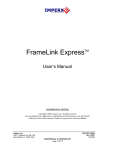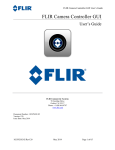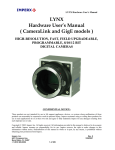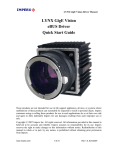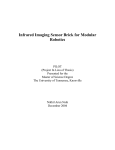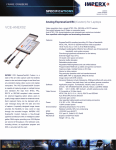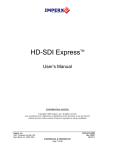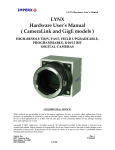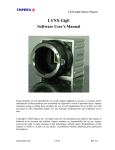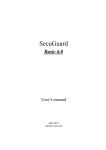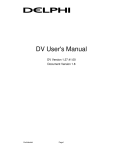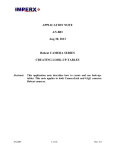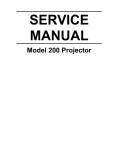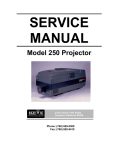Download September 17, 1998
Transcript
FrameLink TM User’s Manual CONFIDENTIAL NOTICE: Copyright ©2002, Imperx, Inc. All rights reserved. Any unauthorized use, duplication or distribution of this document or any part thereof, without the prior written consent of Imperx Corporation is strictly prohibited. Imperx, inc. 6421 Congress Ave Ste. 204 Boca Raton, FL 33487 USA DOC-0011-0002 Rev. RA07 06/24/05 CONFIDENTIAL & PROPRIETARY Page 1 of 59 Revision History RA01 RA02 Dec-9-2003 Feb-10-2004 J. Egri J. Egri Initial Release RA03 Aug-25-2004 J. Egri RA04 Dec-7-2004 J. Egri RA05 May-05-2005 G. Angelone RA06 Jun-08-2005 J. Egri RA07 Jun-22-2005 J. Egri Added Bayer-to-RGB support. Added RGB Gain Control. Updated 8-bit packing. Added “Freeze preview window while capturing” to Series of Frames and AVI dialogs. Added DirectX installation instructions. Changed Multiple Frame Settings dialog in Series of Frames per software release v2.10 Added strobe inversion options to Camera Configuration dialog per software release v2.11. Modified software installation instructions to support Install Shield. Updated Chapter 4 to reflect v2.12 application GUI. Updated software installation instructions for new driver install. Added CC Control dialog to Chapter 4 to reflect v2.13 of application GUI. Updated software installation instructions. Added Appendix A – Serial Communications. Page 2 of 59 Table Of Contents CHAPTER 1 - INTRODUCTION..............................................................................................................................5 FRAMELINK................................................................................................................................................................6 WHAT YOU NEED TO GET STARTED ...........................................................................................................................13 INSPECTING THE FRAMELINK PACKAGE ...................................................................................................................14 CHAPTER 2 – HARDWARE INSTALLATION ...................................................................................................15 CHAPTER 3 – SOFTWARE INSTALLATION ....................................................................................................16 SOFTWARE SUITE .....................................................................................................................................................16 SOFTWARE INSTALLATION FROM CD .......................................................................................................................18 SOFTWARE UPGRADE FROM WEB SITE .....................................................................................................................23 FIRMWARE UPGRADE FROM WEB SITE .....................................................................................................................28 CHAPTER 4 – USING THE FRAMELINK ...........................................................................................................29 RUNNING THE FRAMELINK APPLICATION ................................................................................................................30 MAIN WINDOW ........................................................................................................................................................31 CAMERA PARAMETERS DIALOG ...............................................................................................................................34 CAPTURE SETTINGS DIALOG ....................................................................................................................................41 CC CONTROL DIALOG ..............................................................................................................................................50 PLAYER DIALOG .......................................................................................................................................................54 CHAPTER 5 – ELECTRICAL INTERFACES......................................................................................................55 CAMERA LINK CONNECTOR .....................................................................................................................................56 PCMCIA/CARDBUS CONNECTOR ............................................................................................................................57 CHAPTER 6 - SPECIFICATIONS..........................................................................................................................58 APPENDIX A – SERIAL COMMUNICATIONS ..................................................................................................59 Page 3 of 59 Illustrations Figure 1 – FrameLink Block Diagram...........................................................................................................................8 Figure 2 – Camera Link Interface..................................................................................................................................9 Figure 3 – EEPROM Programming In System............................................................................................................12 Tables Table 1 – Image data bit-to-port assignments per the Camera Link specification.......................................................10 Table 2 – FrameLink Image data mapping into memory.............................................................................................10 Table 3 – Camera Link Connector Pin-out..................................................................................................................56 Table 4 – Cardbus Connector Pin-out..........................................................................................................................57 Page 4 of 59 Chapter 1 - Introduction Introduction This chapter outlines the key features of the Imperx FrameLink card. Page 5 of 59 FrameLink The FrameLink frame grabber is a TYPE II PC Card with both a Camera Link and Cardbus interface. It provides the ability to capture digital video data from a ‘base configuration’ Camera Link interface and transfer that data to host memory via a Cardbus ( PCI ) interface. Functionality • Captures video data from the Camera Link interface, formats this data and stores it into local SDRAM. • Retrieves the formatted data from the SDRAM and transfers it into host memory via DMA over the Cardbus. • Provides a full-duplex asynchronous interface ( UART ) to/from an attached device on the Camera Link’s serial interface. • Provides the host processor with the ability to configure the four discrete Camera Control signals on the Camera Link interface. Interfaces Camera Link interface The FrameLink provides a Camera Link interface that follows the ‘base configuration’, as defined in the Camera Link standard, requiring a single 26 conductor connector/cable ( refer to Figure 2 ). The base configuration consists of multiplexing 28 bits of video data into 4 LVDS data streams. This data consists of 24 bits of pixel data along with 4 pixel qualifier signals: ‘line valid’ strobe, ‘frame valid’ strobe, ‘data valid’ strobe and a spare strobe ( for future use ). A phased-locked transmit clock is transmitted in parallel with the data streams over a fifth LVDS link. Additionally, four RS-644 LVDS streams are included for general purpose camera control. These ‘camera control’ signals allow the frame grabber to manipulate discrete controls within an attached camera. A bi-directional asynchronous communications channel between the frame grabber and an attached camera is also provided by means of two RS-644 LVDS pairs. PCMCIA/CardBus interface The FrameLink card complies with the TYPE II PC Card package dimensions as defined in the PC Card Release 8.0 Standard. It includes a 30mm x 10mm extension area, used to house the CameraLink connector. The FrameLink provides a 33 MHz 32 bit PCI Master/Target interface Page 6 of 59 ( Cardbus ) compliant with the PC Card Release 8.0 specification. This interface provides a single ‘function’, as defined in the Cardbus specification. The design does not support any memory mapped or I/O mapped peripherals on card. Access to the FrameLink’s SDRAM devices is achieved through DMA operations that move the data from the SDRAM into host memory. The host cannot directly access the contents of the SDRAM. The design supports host access into configuration registers, DMA registers, local registers and CIS data via configuration space accesses. Page 7 of 59 32-bit PCI Master/Slave CardBus Connector 68-pin Female Figure 1 – FrameLink Block Diagram Page 8 of 59 SDRAM 4Mx32 BGA-90 Configuration EEPROM EPC2 FPGA ACEX EP1K100 BGA-484 3V-to-2.5V converter SDRAM 4Mx32 BGA-90 OSC 66Mhz SerTFG SerTC CC1 CC2 CC3 CC4 PortA PortB PortC Strobes Clk 8 8 8 4 ByteBlaster Programming Header Camera Link Transceiver 2 2 2 2 2 2 2 2 2 SerTFG 2 SerTC 2 CC1 CC2 CC3 CC4 X0 X1 X2 X3 Xclk Camera Link Connector 26-pin Female A functional block diagram of the FrameLink card is illustrated in Figure 1. A functional block diagram of the Camera Link interface is illustrated in Figure 2. 15 12 12 X0+ Pair 1+ 2 25 Pair 1- 16 11 25 11 X0- X1+ Pair 2+ 3 24 Pair 2- 17 10 24 10 X1- X2+ Pair 3+ 4 23 Pair 3- 19 8 23 8 X2- X3+ Pair 5+ X3- 26-pin Female MDR Connector 18 21 26-pin Male MDR Connector 21 Pair 5- 26-pin Male MDR Connector 6 9 9 Xclk+ 22 22 Xclk- 15 15 CC4+ 2 2 CC4- 3 3 CC3+ 16 16 CC3- 17 17 CC2+ 4 4 CC2- 5 5 CC1+ 18 18 CC1- 6 6 SerTFG+ 19 19 SerTFG- 20 20 SerTC+ 7 7 SerTC- Rx17 Port C7 Rx16 Rx22 Port C6 Port C5 Rx21 Rx20 Port C4 Port C3 Rx19 Port C2 Rx18 Rx15 Port C1 Port C0 Rx11 Rx10 Port B7 Port B6 Rx14 Port B5 Rx13 Rx12 Port B4 Port B3 Rx9 Rx8 Port B2 Port B1 Rx7 Port B0 Rx5 Rx27 Port A7 Port A6 Rx6 Rx4 Port A5 Port A4 Rx3 Port A3 Rx2 Rx1 Port A2 Port A1 Rx0 Port A0 Rx26 Rx25 DVAL FVAL Rx24 LVAL Rx23 spare Pair 4+ RxCLKOut 5 Pair 4- 12 Pair 11+ 25 CC4 Pair 11- 24 Pair 10+ 11 CC3 Pair 10- 10 Pair 9+ 23 CC2 Pair 9- 22 Pair 8+ 9 CC1 Pair 8- 21 Pair 7+ SerTFG 8 Pair 7- 7 Pair 6+ SerTC 20 Pair 6- 1 Inner Shield 1 1 13 14 Inner Shield Inner Shield 13 14 13 14 Inner Shield 26 26 26 Camera Link Cable FrameLink Frame Grabber Figure 2 – Camera Link Interface Page 9 of 59 Clock Video Capture The video capture engine is responsible for receiving video pixel data and qualifiers from the Camera Link transceivers, formatting the data and transferring it into on-board memory. The data that it receives from the Camera Link transceivers is formatted per Table 1. Ten different modes of operation are supported as indicated in the table. The video capture engine translates this data into longwords ( 32 bits ), as defined in Table 2, in order to use the Cardbus bandwidth more efficiently and conserve memory space. Table 2 reflects how the data will appear in host memory. In the case of the single tap and dual tap 8 bit modes, the module packs four pixels into each longword. In the case of the other modes, excluding 3x8 and RGB, the module packs two pixels into each longword. Por t C Por t B c7 c6 c5 c4 C3 c2 c1 c0 b7 b6 b5 b4 b3 b2 b1 b0 a7 A7 B7 B6 B5 B4 B3 B2 B1 B0 A7 C7 C6 C5 C4 C3 C2 C1 C0 B7 B6 B5 B4 B3 B2 B1 B0 A7 a6 A6 A6 A6 a5 A5 A5 A5 Por t A a4 a3 A4 A3 A4 A3 A4 A3 a2 A2 A2 A2 a1 A1 A1 A1 a0 A0 A0 A0 MODE 1x8 2x8 3X8 A9 A8 A7 A6 A5 A4 A3 A2 A1 A0 A9 A8 A7 A6 A5 A4 A3 A2 A1 A0 1x10 2x10 A11 A10 A9 A8 A7 A6 A5 A4 A3 A2 A1 A0 B7 B6 B5 B4 B3 B2 B1 B0 B11 B10 B9 B8 A11 A10 A9 A8 A7 A6 A5 A4 A3 A2 A1 A0 1x12 2x12 A13 A12 A11 A10 A9 A8 A7 A6 A5 A4 A3 A2 A1 A0 1x14 A15 A14 A13 A12 A11 A10 A9 A8 A7 A6 A5 A4 A3 A2 A1 A0 1x16 B7 B6 B5 B4 B3 B2 B1 B0 B9 B8 BL7 BL6 BL5 BL4 BL3 BL2 BL1 BL0 GR7 GR6 GR5 GR4 GR5 GR2 GR1 GR0 RD7 RD6 RD5 RD4 RD3 RD2 RD1 RD0 RGB (1x24) Table 1 – Image data bit-to-port assignments per the Camera Link specification d31 d30 d29 d28 d27 d26 d25 d24 d23 A7 A6 A5 A4 A3 A2 A1 A0 A7 B7 B6 B5 B4 B3 B2 B1 B0 A7 C7 d22 A6 A6 C6 d21 A5 A5 C5 d20 A4 A4 C4 d19 A3 A3 C3 d18 A2 A2 C2 d17 A1 A1 C1 d16 A0 A0 C0 d15 A7 B7 B7 d14 A6 B6 B6 d13 A5 B5 B5 d12 A4 B4 B4 d11 A3 B3 B3 d10 A2 B2 B2 d9 A1 B1 B1 d8 A0 B0 B0 d7 A7 A7 A7 d6 A6 A6 A6 d5 A5 A5 A5 d4 A4 A4 A4 d3 A3 A3 A3 d2 A2 A2 A2 d1 A1 A1 A1 d0 A0 A0 A0 MODE 1x8 2x8 3X8 A9 A8 A7 A6 A5 A4 A3 A2 A1 A0 B9 B8 B7 B6 B5 B4 B3 B2 B1 B0 A9 A8 A7 A6 A5 A4 A3 A2 A1 A0 1x10 A9 A8 A7 A6 A5 A4 A3 A2 A1 A0 2x10 A11 A10 A9 A8 A7 A6 A5 A4 A3 A2 A1 A0 B11 B10 B9 B8 B7 B6 B5 B4 B3 B2 B1 B0 A11 A10 A9 A8 A7 A6 A5 A4 A3 A2 A1 A0 1x12 A11 A10 A9 A8 A7 A6 A5 A4 A3 A2 A1 A0 2x12 A13 A12 A11 A10 A9 A8 A7 A6 A5 A4 A3 A2 A1 A0 A13 A12 A11 A10 A9 A8 A7 A6 A5 A4 A3 A2 A1 A0 1x14 A15 A14 A13 A12 A11 A10 A9 A8 A7 A6 A5 A4 A3 A2 A1 A0 A15 A14 A13 A12 A11 A10 A9 A8 A7 A6 A5 A4 A3 A2 A1 A0 1x16 RD7 RD6 RD5 RD4 RD3 RD2 RD1 RD0 GR7 GR6 GR5 GR4 GR3 GR2 GR1 GR0 BL7 BL6 BL5 BL4 BL3 BL2 BL1 BL0 RGB Table 2 – FrameLink Image data mapping into memory Pixel Buffering The pixel data formatted by the video capture engine is stored into two Page 10 of 59 on-board 4Mx32 SDRAM devices. This memory serves as a local store for formatted video pixel data. Each SDRAM will buffer a single frame’s worth of data, supporting a maximum frame size of 8 million pixels/frame in all modes except RGB. In the RGB mode, the maximum frame size supported is 4 million pixels. The SDRAMs are managed by an independent pair of controllers, implemented in the FPGA, supporting concurrent operation. The two SDRAMs are utilized in a ping-pong fashion such that while one is being filled with new pixel data, the other is being emptied via DMA into host memory. DMA The DMA engine is responsible for reading formatted pixel data from the on-board SDRAM devices and transferring them into host memory via the Cardbus interface. An intelligent scatter-gather method is utilized, providing for an efficient use of the Cardbus bandwidth. The use of noncontiguous 4Kbyte buffers provides support for the Windows operating system’s memory allocation model. Serial Interface A bi-directional Universal Asynchronous Receiver Transmitter ( UART ) is provided for the Camera Link serial interface. It transmits and receives ASYNC formatted characters with 1 Start bit, 8 data bits, no parity and 1 Stop bit. The baud rate of this interface can be configured by the user to be any one of a set of standard bit rates ranging from 4800 to 115.2K bits per second. A software interface to the UART is provided by means of a Camera Link compliant ‘clservce.dll’ file. Camera Control The FrameLink card provides four discrete camera control bits per the Camera Link specification. These bits can be configured by the user via the FrameLink application GUI. FPGA The heart of the FrameLink is a dense Field Programmable Gate Array ( FPGA ). This FPGA implements all of the functions related to video data capture, storage and DMA. The firmware contents of the FPGA can be upgraded while in the field by following the instruction outlined in Section 3 of this document entitled ‘Firmware Upgrade from Web Site’. In System Programming: The FrameLink design supports ISP programming during operation. This capability is useful when the FPGA code needs to be upgraded and the unit is at a remote customer location. The programming is accomplished using a JamPlayer utility, which runs on the host PC. The JamPlayer utility downloads a new FPGA image into the EEPROM via the Cardbus interface. The FPGA provides a set of I/O pins which are connected to the EEPROM’s JTAG interface. The JamPlayer utility toggles these I/O pins, which are mapped into a register in configuration space, and thus can communicate with the EEPROM’s JTAG controller and affect a programming operation. Page 11 of 59 I/O I/O I/O Cardbus Interface I/O FPGA TCK TMS TDI Configuration EEPROM Cardbus Connector TCK TMS ISP TDO TDI TDO FrameLink Card Figure 3 – EEPROM Programming In System Page 12 of 59 Not Used PC w/JamPlayer What you need to get started To begin using the FrameLink card, you need the following: • A computer with a PCMCIA slot that is Cardbus compliant. • Microsoft Windows XP or 2000 software. • A computer with a relatively up to date Cardbus-to-PCI chipset ( sometimes referred to as a ‘Cardbus Controller’ ). You can determine which chipset your laptop uses by looking in: Control Panel – System – Hardware – Device Manager – PCMCIA Adapters These chipsets are recommended because they generally offer better performance in terms of DMA transfer rates: TI PCI-1520 TI PCI-4510 These chipsets are discouraged because of their poor DMA performance: O2 Micro OZ6912 TI PCI-1225 • A computer with at least 256M bytes of RAM. • A CD drive, and a hard disk on which to install the FrameLink software. Page 13 of 59 Inspecting the FrameLink package When you unpack your FrameLink package, you should visually inspect all of its contents. If something is missing or damaged, contact your Imperx representative. Package contents You should have received the following items: • The FrameLink PCMCIA card • A metal ‘strain relief’ bracket • A CD with the FrameLink software suite • A ‘Quick Start’ installation guide • A ‘User’s Manual’ ( this document ) Page 14 of 59 Chapter 2 – Hardware Installation Hardware Installation Installing the FrameLink card is as simple as plugging it into an available PCMCIA slot on your computer. Note that the card should be plugged in with the CameraLink connector facing up and away from the computer. Page 15 of 59 Chapter 3 – Software Installation Software Installation This chapter explains how to install the FrameLink software. Software Suite The FrameLink software suite consists of the following files: Windows XP and 2000 application files: ( located in c:\Program_Files\ImperX\FrameLink\ ) AMCap.exe clservce.dll console.exe ijl20.dll VCECLB.dll VCECLB_app.chm VCECLB_app.exe VCECLB-LS_app.exe VceComX.exe - DirectX sample application - CameraLink serial interface library - console program ( for debug purposes ) - Intel JPEG encoding/decoding library - FrameLink library - FrameLink help file - FrameLink Area Scan application - FrameLink Line Scan application - Virtual COM port emulator Windows XP and 2000 driver files: ( located in c:\Program_Files\ImperX\FrameLink\Drivers\WDM\ ) vceclb.sys vceclb.inf ipxinstdrv.exe - FrameLink WinXP/2000 driver file - FrameLink WinXP/2000 driver info file - WDM Streaming installation program Page 16 of 59 Streaming Kernel Driver ( DirectX ) files: ( located in c:\Program_Files\ImperX\FrameLink\Drivers\DirectX\ ) Vceclbks.sys Vceclbks.inf VceClbKs.ax - FrameLink WDM Streaming driver - FrameLink WDM Streaming info file - WDM Streaming driver’s properties plugin Documentation files: ( located in c:\Program_Files\ImperX\FrameLink\Doc\ ) FrameLink_Users_Manual.pdf - User manual document FrameLinkSpec.pdf - Technical datasheet History_drv.txt - WDM driver change description file History_ks.txt - KS driver change description file History_app.txt - Application change description file Cam Files: ( located in c:\Program_Files\ImperX\FrameLink\Cam_Files\ ) IPX folder MDC folder LYNX folder - FrameLink configuration files for Imperx’ IPX series of cameras - FrameLink configuration files for Imperx’ MDC series of cameras - FrameLink configuration files for Imperx’ LYNX series of cameras Note that our FrameLink application program was created using our SDK ( software developers kit ). Our SDK is a separately purchased product and is not included in the standard FrameLink software suite that comes with the card. For more information on the SDK, please visit our web site at http://www.imperx.com/sdk/index.php or call us toll free at 1-877-863-1654. Page 17 of 59 Software Installation from CD Use the following steps to install the FrameLink software supplied on a CD: 1. If a version of FrameLink was previously installed on this machine, then you must first remove it: To remove the application files: 1.1 1.2 1.3 1.4 1.5 1.6 1.7 1.8 1.9 2. Left mouse click on “Start” Left mouse click on “Settings”. Left mouse click on “Control Panel”. Double left mouse click on “Add or Remove Programs”. Left mouse click on “FrameLink”. Left mouse click on “Remove”. If the ‘FrameLink – InstallShield Wizard’ pops-up, do the following: If not, go to step 1.8 Left mouse click on ‘Remove’. Click ‘Next’. Click ‘Yes’. Click ‘Finish’. Left mouse click on “Yes”. Left mouse click on “Close”. After having removed a previous version or if a version of FrameLink was NOT previously installed on this machine then: The first step is to install the application files: 2.1 2.2 2.3 2.4 Insert the FrameLink CD into the appropriate drive; the setup.exe file will run automatically. Note: If it does not start automatically, left mouse click on to “Start”, “Run”, enter or browse to “(CD drive): setup.exe” and click “OK”. Wait for the “FrameLink - InstallShield Wizard” screen to appear. Follow the on-screen instructions. For Windows XP, the following message will appear: Page 18 of 59 For Windows 2000, the following message will appear: 2.5 2.6 Click “Continue Anyway” for XP, “Yes” for 2000. When the following message appears, choose if you would like to register online by left clicking on “Yes” or “No”. If you choose “Yes”, follow the on-screen instructions. Page 19 of 59 2.7 When prompted, select ”Yes, I will restart my computer now”. After restarting the computer a New Hardware Found screen will come up: ( the FrameLink card must be installed to perform the following steps ) Steps 2.8 through 2.14 are for Windows XP. For Windows 2000, go to Step 2.15 2.8 2.9 Wait for the system to prompt you with a “Found New Hardware Wizard” dialog box. Under certain conditions, the following message may appear: If this message appears, click “No, not this time”, then “Next”. Page 20 of 59 2.10 When the following message appears, select “Install the software automatically (Recommended)”, then left click “Next”. 2.11 For Windows XP, the following message will appear: 2.12 2.13 Click “Continue Anyway” to continue. When “Click Finish to close the wizard” appears, Left click on “Finish”. This completes the installation for Windows XP. 2.14 To install the WDM driver for Windows 2000: 2.15 Wait for the system to prompt you with a “Found New Hardware Wizard” dialog box. Page 21 of 59 2.16 Left click “Next” to continue. The following message will appear: Click “Yes” to continue. 2.17 2.18 2.19 Click “OK” , then either enter or browse to: C:\Program Files\ImperX\FrameLink\Drivers\WDM Click “OK” This completes the installation for Windows 2000. Page 22 of 59 Software Upgrade from Web Site New application and/or driver software may be released periodically to reflect improvements and/or functionality added to the FrameLink. You can retrieve these updates by visiting the download page of our web site at http://www.imperx.com/frame_grabbers/camera_link/FrameLink_downloads.php Use the following steps to install newly released application software: 3.1 3.2 3.3 3.4 3.5 3.6 Uninstall all application files by following the instructions in step 1. of the ‘Software Installation from CD’ section. Download the FrameLink_Installer.exe file from the Imperx web site to a new folder on your PC ( we will use the folder C:\new_FrameLink as an example ). Left mouse click on “Start”, “Run”, enter or browse to “C:\new_FrameLink\FrameLink_Installer.exe”. Left mouse click on “Open”, then “OK”. Follow the on-screen instructions. For XP, when the following message appears, left click “Continue Anyway” Page 23 of 59 For Windows 2000, when the following message appears, click “Yes”. 3.7 When the following message appears, choose if you would like to register online by left clicking on “Yes” or “No”. If you choose “Yes”, follow the on-screen instructions. 3.8 4. When prompted, select ”Yes, I want to restart my computer now” and left click “Finish”. After having successfully installed the newly released application software, use the following steps to install a newly released WDM driver for Windows XP ( for Windows 2000 go to step 5. ): 4.1 Wait for the system to prompt you with a “New Hardware Found” dialog box. Page 24 of 59 4.2 Under certain conditions, the following message may appear: If this message appears, click “No, not this time”, then “Next”. 4.3 When the following message appears, select “Install the software automatically (Recommended)”, then left click “Next”. Page 25 of 59 4.4 For XP, when the following message appears, left click “Continue Anyway”. 4.5 When “Click Finish to close the wizard” appears, Left click on “Finish”. This completes the installation for Windows XP. 4.6 5. After having successfully installed the newly released application software, use the following steps to install a newly released WDM driver for Windows 2000: 5.1 Wait for the system to prompt you with a “Found New Hardware Wizard” dialog box. 5.2 Left click “Next” to continue. The following message will appear: Page 26 of 59 5.3 Click “Yes” to continue. 5.4 Click “OK” , then either enter or browse to: C:\Program Files\ImperX\FrameLink\Drivers\WDM Click “OK”. This completes the installation for Windows 2000. 5.5 5.6 Page 27 of 59 Firmware Upgrade from Web Site Your newly received FrameLink card has been programmed in the factory with the latest firmware prior to shipping. New firmware, however, may be released periodically to reflect improvements and/or functionality added to the FrameLink FPGA. You can retrieve these updates by visiting the download page of our web site at http://www.imperx.com/frame_grabbers/camera_link/FrameLink_downloads.php Use the following steps to install newly released firmware: 1. Download and unzip the firmware patch ( .zip ) file to a folder on your PC ( we will use C:\fw_patch as an example ). 2. If you haven't previously installed the JamPCI drivers then: 2.1 Left mouse click on to “Start”, “Run”, enter “C:/fw_patch/loadsys.bat” and click ”OK”. 2.2 Wait until "Press any key to continue . . ." message appears. 2.3 Press any key to exit batch file. 3. Insert the FrameLink card into the laptop. Note that if your system has two PCMCIA slots, then you must insert the card into the slot in which it was placed during the original driver installation. 4. If the system prompts you with a “New Hardware Found” dialog box, press “Cancel”. 5. Note: DO NOT POWER DOWN OR REMOVE CARD WHILE PROGRAMMING IS IN PROGRESS! 6. Left mouse click on “Start”, “Run”, enter “C:/fw_patch/FrameLink_patch_x_y.bat” and click ”OK”. Note that ‘x_y’ refers to the revision number ( i.e. 2.0 ). 7. Wait until "Press any key to continue . . ." message appears. 8. If line above it reads "Exit code = 0...Success" then proceed with installation, otherwise contact [email protected]. 9. Press any key to exit batch file. 10. You must either reboot the PC or remove and then reinsert the FrameLink card in order for the changes to take effect Page 28 of 59 Chapter 4 – Using the FrameLink Using the FrameLink This chapter contains information on how to configure and use the FrameLink card. Page 29 of 59 Running the FrameLink Application The VCECLB_app.exe program supplied with the FrameLink card is a stand-alone Windows based application. It provides an easy to use graphical user interface ( GUI ), allowing the user to configure the FrameLink card and to view, record and playback video data received from the CameraLink interface. The application consists of a main window as well as ‘Camera Configuration’, ‘Control Panel’ and ‘Player’ dialog windows. Launching Application To launch the FrameLink application, simply double left mouse click on the ‘FrameLink application’ icon on the desktop. Note In the remainder of this chapter, references to ‘clicking’ on objects in the GUI refers to the left mouse button. Page 30 of 59 Main Window When the VCECLB_app.exe program is executed, a main window titled ‘FrameLink™ Application’ will appear. The main window provides the primary area for viewing real-time images received from the camera. This window can be sized and moved to suit your needs. When image viewing is active, the size of this window will be automatically scaled as a function of the camera parameters ( i.e. pixels/ line and lines/frame ) specified in the ‘Camera Parameters’ dialog. File Zoom Clicking on this item reveals a pull-down menu with two options: ‘Player’ and ‘Exit’. Player This option opens the ‘Player Dialog’ and ‘Player Control’ windows. Exit Clicking on this option causes the program to terminate. Reveals a pull-down menu which allow the user to select the image scaling factor. The image scaling factor determines the size of the display window and the captured image. Changing from one scale to another scale automatically updates the display window and image size. Page 31 of 59 Control Panel Clicking on this item reveals a pull-down menu with the following options: Capture Settings Selecting this item causes the ‘Capture Settings’ dialog to appear. Alternatively, Ctrl-S can be used to open/close this dialog. Camera Parameters Selecting this item causes the ‘Camera Parameters’ dialog to appear. Alternatively, Ctrl-P can be used to open/close this dialog. RGB Gain Select this option when you wish to adjust each of the RGB color components. This option is only available if ‘Bayer’ or ‘RGB’ is selected in the ‘video type’ field of the ‘Camera Parameters’ dialog. Clicking on this button causes the ‘RGB Gain Control’ dialog window to open. Alternatively, Ctrl-R can be used to open/close this dialog. CC Control Selecting this item causes the ‘CC Control’ dialog to appear. Alternatively, Ctrl-C can be used to open/close this dialog. Camera This button lets you choose which camera you would like to use. Note that this option is only viable for the FrameLink-JFLEX dual port card. It has no effect for the standard FrameLink. Start/Stop Grab This button will toggle between ‘Start Grab’ and ‘Stop Grab’ every time the user clicks on it. Clicking on ‘Start Grab ‘enables the FrameLink’s DMA engine and causes the main window to display live images received from the camera. Clicking on ‘Stop Grab’ disables the DMA engine and causes the display to freeze. Page 32 of 59 Start/Stop Capture This button will toggle between ‘Start Capture’ and ‘Stop Capture’ every time the user clicks on it. Clicking on ‘Start Capture‘ starts the process of recording the images to disk. The options set in the ‘Capture Options’ field determine what, how and when actual recording is performed. Clicking on ‘Stop Capture’ causes recording to stop. Help Clicking on this item reveals a pull-down menu with two options: ‘About’ and ‘Help Manual’. About Clicking on this option causes version information to be displayed including release identifiers for the application software, library, driver and firmware. This information should be provided to Imperx technical support personnel during a service call. Help Manual Clicking on this option causes an interactive point-and-click style help manual to be displayed. The help manual provides a summary description of all GUI controls and fields. Status Indicators On the bottom of the window are two status indicators: ‘Camera’ status and ‘DMA’ status. Camera Status Displays the real-time status of the attached camera as being either ‘online’ or ‘offline’. ‘Online’ indicates that the camera is powered on, attached and providing a video clock via the CameraLink interface. ‘Offline’ indicates that the FrameLink card is not receiving a video clock from the camera either because the camera is powered off or the CameraLink cable is disconnected. DMA Status Displays the real-time status of the DMA process as being either ‘active’ or ‘inactive’. ‘Active’ indicates that the user has commanded the FrameLink to acquire video data by clicking on the ‘start grab’ button and that the camera is providing valid framing ( FVAL signal toggling ). ‘Inactive’ indicates that either the user has commanded the FrameLink to stop acquiring video data by clicking on the ‘stop grab’ button or that grabbing is enabled but the camera is not providing valid framing ( no FVAL signal ) Page 33 of 59 Camera Parameters Dialog When the VCECLB_app.exe program is executed, a ‘Camera Parameters’ dialog will appear. The Camera Parameters screen allows the user to program the FrameLink card with the operating parameters of the attached camera. For the FrameLink card to be able to properly acquire and display images from an attached camera, the settings entered into this screen must match the parameters of the camera. Manufacturer Model Description These text fields allow the user to record the vendor and part number of the attached camera. This text, along with all of the other settings, can then be saved as a .CAM file on the PC for later retrieval. Load Loads a previously saved camera configuration file. Clicking on this box will cause a Windows ‘browse’ box to appear. The user can then browse to the folder and file he wishes to open. The program will then open the selected file, parse it and populate the fields in the GUI. Save Saves the current GUI fields as a camera configuration file. Clicking on this box will cause a Windows ‘browse’ box to appear. The user can then browse to a folder and enter a file name. The program will then create a .CAM file using the values in the GUI’s fields and write it to the disk. Page 34 of 59 Dimension These fields specify the geometry of the attached camera and instruct the FrameLink on how to reconstruct a received image. Width (pixels): These fields specify the total number of pixels per line. The Camera Link standard defines a line as being a series of pixels enveloped by the LVAL strobe and qualified by the DVAL strobe. Cameras generally provide some leading and trailing dummy pixels before and after a set of valid pixels. Most cameras can disqualify these dummy pixels by negating the DVAL signal. For cameras that do not disqualify the dummy pixels, the FrameLink has to be told the number of pre-valid, valid and post-valid pixels in order to properly construct an image. Pre-valid Specifies the number of leading pixels prior to any valid pixels. The FrameLink will exclude these pixels from the displayed/captured image. Valid Specifies the number of valid pixels. The FrameLink will include these pixels in the displayed/captured image. Post-valid Specifies the number of trailing pixels following any valid pixels. The FrameLink will exclude these pixels from the displayed/captured image. Height (lines): These fields specify the total number of lines per frame. The Camera Link standard defines a frame as being a series of lines enveloped by the FVAL strobe. Cameras can sometimes provide some leading and trailing dummy lines before and after a set of valid lines. Most cameras can disqualify these dummy lines by negating the FVAL signal. For cameras that do not disqualify the dummy lines, the FrameLink has to be told the number of prevalid, valid and post-valid lines in order to properly construct an image. Pre-valid Specifies the number of leading lines prior to any valid lines. The FrameLink will exclude these lines from the displayed/captured image. Valid Specifies the number of valid lines. The FrameLink will include these lines in the displayed/captured image. Post-valid Specifies the number of trailing lines following any valid lines. The FrameLink will exclude these Page 35 of 59 lines from the displayed/captured image. Taps Specifies the number of taps ( channels ) of video data provided by the attached camera. Dual Mode This field specifies the order in which the pixels are received from the Camera when operating in the dual tap mode. Two formats are supported: ‘Horizontal sequential’ and ‘Horizontal interlaced’. Horizontal Sequential This should be selected when the camera delivers pixels in the following order ( where n = total number of pixels in the line ): TAP #1 Pixel # 1 Pixel # 2 Pixel # (n/2) -1 Pixel # n/2 TAP #2 Pixel # n Pixel # n-1 Pixel # (n/2)+2 Pixel # (n/2)+1 For example: For a camera with 1004 pixels/line in Horizontal Sequential dual progressive mode: TAP #1 Pixel # 1 Pixel # 2 Pixel # 501 Pixel # 502 TAP #2 Pixel # 1004 Pixel # 1003 Pixel # 504 Pixel # 503 Page 36 of 59 Horizontal Interlaced This should be selected when the camera delivers pixels in the following order ( where n = total number of pixels in the line ) TAP #1 Pixel # 1 Pixel # 3 Pixel # n-3 Pixel # n-1 TAP #2 Pixel # 2 Pixel # 4 Pixel # n-2 Pixel # n For example: For a camera with 1004 pixels/line in Horizontal Interlaced dual progressive mode: TAP #1 Pixel # 1 Pixel # 3 Pixel # 1001 Pixel # 1003 TAP #2 Pixel # 2 Pixel # 4 Pixel # 1002 Pixel # 1004 Reverse Tap Configures the FrameLink to reverse the pixel order of the displayed image ( mirror left-to-right or right-to-left ) of either Tap #1 , Tap #2 or both taps. Page 37 of 59 Strobes Specifies how to treat the Camera Link strobes, where ‘DVAL’ is data valid, ‘LVAL’ is line valid and ‘FVAL’ is frame valid. Ignore DVAL Instructs the FrameLink card to ignore the ‘DVAL’ signal received from the CameraLink interface. Pixel capture will be qualified with the ‘FVAL’ and ‘LVAL’ signals only. Invert DVAL Instructs the FrameLink card to invert the ‘DVAL’ signal received from the CameraLink interface prior to processing it. Invert LVAL Instructs the FrameLink card to invert the ‘LVAL’ signal received from the CameraLink interface prior to processing it. Invert FVAL Instructs the FrameLink card to invert the ‘FVAL’ signal received from the CameraLink interface prior to processing it. Video Type Specifies the video mode as either or monochrome, Bayer or RGB ( 24 bit ). Camera Bit Depth Specifies the number of bits per pixel when the video type is monochrome. When the video type is RGB, the depth is fixed at 24 bits. Control Bits Specifies the state of the four camera control signals ( CC1 – CC4 ) of the CameraLink interface. An unchecked box represents a negated signal ( logic-0 ), while a checked box represents an asserted signal ( logic-1 ) Bayer Start Specifies the starting pixel in the bayer pattern as provided by the camera. This selection is typically required when a camera is operated with an ‘area of interest’ feature enabled. For the following examples, assume that ‘n = number of pixels/line’ and ‘m = number of lines’ then: Pattern #1 Use this selection when the camera provides the following pattern: Line 1 2 3 4 : m-1 m 1 G B G B 2 R G R G 3 G B G B G B R G G B Pixel 4 R G R G R G … n-1 G B G B n R G R G G B R G An example of this is when the camera is operated in a normal Page 38 of 59 mode or when its horizontal window starts on an odd pixel and its vertical window starts on an odd line. Pattern #2 Use this selection when the camera provides the following pattern: Line 1 2 3 4 : m-1 m 1 R G R G 2 G B G B 3 R G R G R G G B R G Pixel 4 G B G B … G B n-1 R G R G n G B G B R G G B An example of this is when the camera’s horizontal window starts on an even pixel and its vertical window starts on an odd line. Pattern #3 Use this selection when the camera provides the following pattern: Line 1 2 3 4 : m-1 m 1 B G B G 2 G R G R 3 B G B G B G G R B G Pixel 4 G R G R … G R n-1 B G B G n G R G R B G G R An example of this is when the camera’s horizontal window starts on an odd pixel and its vertical window starts on an even line. Pattern #4 Use this selection when the camera provides the following pattern: Line 1 2 3 4 : m-1 m 1 G R G R 2 B G B G 3 G R G R G R B G G R Pixel 4 B G B G B G … An of this is when the camera’s horizontal window starts Page 39 of 59 n-1 G R G R n B G B G G R B G example on an even pixel and its vertical window starts on an even line. SerialLink BaudRate Specifies the data transfer speed of the CameraLink’s serial interface. Clicking on this box causes a pull-down menu to appear. The user can then select the desired baud rate from among the choices presented, ranging from 9600 to 115,200 bits per second. This setting must match the camera’s requirements. Apply Causes the application to apply the current settings to the FrameLink card. Start/Stop Grab This button will toggle between ‘Start Grab’ and ‘Stop Grab’ every time the user clicks on it. Clicking on ‘Start Grab’ enables the FrameLink’s DMA engine and causes the main window to display live images received from the camera. Clicking on ‘Stop Grab’ disables the DMA engine and causes the display to freeze. Close This button will hide the Camera Parameters dialog screen. You can invoke it again by either hitting Ctrl-P or by selecting it from the Control Panel pull-down menu. Page 40 of 59 Capture Settings Dialog This dialog can be invoked by either hitting Ctrl-S or by selecting it from the Control Panel pull-down menu. This dialog gives the user complete control over image storage. The window can be moved anywhere around the screen to suit your needs. Start/Stop Capture This button will toggle between ‘Start Capture’ and ‘Stop Capture’ every time the user clicks on it. Clicking on ‘Start Capture‘ starts the process of recording the images to disk. The options set in the ‘Capture Options’ field determine what, how and when actual recording is performed. Clicking on ‘Stop Capture’ causes recording to stop. Close This button will hide the Capture Settings Dialog screen. You can invoke it again by either hitting Ctrl-S or by selecting it from the Control Panel pull-down menu. Image Format When recording images to disk, this option selects the format, ‘BMP’, ‘JPEG’ or ‘TIFF’, that the image will be saved in. Selecting ‘JPEG’ activates a compression slider. ‘Best Quality’ provides the least compression while ‘Smallest File’ provides the most compression. Pixel Padding Pixel padding defines the way in which TIFF files are created. Since a TIFF file uses 16 bits to represent each pixel and cameras can produce less than 16 bit pixels, the pixel padding option is provided. ‘Left’ pixel padding means that 16 bit TIFF data is produced by appending zeros to the MSB bits of the pixel data. For example, for a 12 bit pixel the resultant 16 bit TIFF data is “0,0,0,0,p12, p11….p2,p1” where p12..p1 represent the 12 Page 41 of 59 bit pixel. Left padding is useful when the user wishes to post-process the TIFF data. ‘Right’ pixel padding means that 16 bit TIFF data is produced by shifting the pixel data left and appending zeros to the LSB bits of the pixel data. For example, for a 12 bit pixel the resultant 16 bit TIFF data is “p12, p11….p2,p1,0,0,0,0”. Right padding is useful when the user wishes to view the TIFF data using a standard TIFF viewer program. Capture Options Determines how, when and where images are recorded to disk. Three choices are provided: ‘Single Frames’, ‘Series of Frames’ and ‘AVI Video’. Clicking on each option opens a new dialog window providing additional options. Single Frames Select this option when you wish to record one frame only. Clicking on this button causes the ‘Single Frame Settings’ dialog window to open. Path/Filename This text field allows you to provide a path and filename for the recorded image file. Clicking on the ‘…’ box will cause a Windows ‘browse’ box to appear. The user can then browse to a folder and enter a file name. The filename extension, .BMP or .JPG, will automatically be added depending on the image format chosen and therefore you do not need to include the filename extension. Text Overlay Enabling ‘Insert Date and Time’ automatically places the date and time on each image recorded. Date and time formats are the same as those used on your computer. Enabling ‘Insert Text Message’ allows you to enter a text string to be automatically overlayed on each image recorded. Clicking on ‘Position’ causes a pull-down menu to appear Page 42 of 59 which defines the placement position of the date/time/text message within the image. Available options include: Top-Left, Top-Center, Top-Right, Bottom-Left, Bottom-Center and Bottom-Right. Accept Clicking on this causes the entries made to the various fields to be accepted and then closes the ‘Single Frame Settings’ dialog window. Cancel Clicking on this causes the entries made to the various fields to be rejected and then closes the ‘Single Frame Settings’ dialog window. Series of Frames Select this option when you wish to record multiple frames. Clicking on this button causes the ‘Series of Frames Settings’ dialog window to open. Path/Filename This text field allows you to provide a path to a folder where the recorded image files will be saved Page 43 of 59 to. Clicking on the ‘…’ box will cause a Windows ‘browse’ box to appear. The user can then browse to a folder. The filename will automatically be created based on the choice made in the ‘Append to filename’ option. The filename extension, .BMP or .JPG, will automatically be added depending on the image format chosen. Append to filename Allows the user to choose the format of the text filename to be created. Every time a recording file is created, the filename suffix will automatically be updated ( for the ‘Date and Time’ option ) or incremented ( for the ‘N Digit Number’ option ). Date and Time This option will create files named as YYYYMMDDhhmmssnnn where: Y - year (4 digits) M - month (2 digits) D - day (2 digits) h - hour (2 digits) m - minute (2 digits) s - second (2 digits) n - millisecond (3 digits) ‘N’ Digit Number This option will create numerically named files. The filename starts at 0 and is incremented by one after each frame is captured. If the number of frames captured exceeds the number of digits selected then the filename will continue to increment. For example: If ‘2 Digit Number’ is selected then the files will be named as: ‘00.bmp’, ‘01.bmp’ … ‘99.bmp’, ‘100.bmp’, ‘101.bmp’, etc. If ‘4 Digit Number’ is selected then the files will be named as: Capture event occurs: ‘0000.bmp’, ‘0001.bmp’ … ‘9999.bmp’, ‘10000.bmp’, ‘10001.bmp’, etc. Allows you to control how often to start capturing images. Capture every Specifies how often, in time, to start Page 44 of 59 capturing images. Use this feature to take snapshots at regular intervals in order to create a time-lapse series of images. This option is mutually exclusive with the ‘Continuous’ option. Continuous Specifies that image capture is free-running. Capture duration Allows you to control how much to capture with for each event: each capture event specified above. Limits can be specified by either time or number of frames, whichever occurs first. Limit capture time to Allows you to limit the duration of the recording by the amount of time specified. Limit number of frames to Allows you to limit the duration of the recording by the number of frames specified. Total capture: Allows you to control how much to capture over all events specified above. Limits can be specified by either time or number of frames, whichever occurs first. Limit total capture Allows you to limit the duration of the total time to recording by the amount of time specified. Limit total number Allows you to limit the duration of the total of frames to recording by the number of frames specified Examples of how to use Capture timers and counters: Example #1: To capture 5 frames, every 1.5 hours, over a 12 hour period. Capture event occurs: Page 45 of 59 Capture every: 01 Hr 30 Min 00 Sec Capture duration for each event: Limit number of frames to: 5 Total capture: Limit total capture time to: 12 Hr 00 Min 00 Sec Example #2: To capture 5 minutes worth of images, every 15 minutes and not to exceed a total of 250 images. Capture event occurs: Capture every: 00 Hr 15 Min 00 Sec Capture duration for each event: Limit capture time to: 00 Hr 05 Min 00 Sec Total capture: Limit total number of frames to: 250 Example #3: To capture 10 frames, every 1 hour, over a 6 hour period and not to exceed a total of 300 images. Capture event occurs: Capture every: 01 Hr 00 Min 00 Sec Capture duration for each event: Limit number of frames to: 10 Total capture: Limit total capture time to: 06 Hr 00 Min 00 Sec Limit total number of frames to: 300 Example #4: To capture continuously for a period of 2 hours and not to exceed a total of 100 images. Capture event occurs: Continuous Total capture: Limit total capture time to: 02 Hr 00 Min 00 Sec Limit total number of frames to: 100 Buffer frames to memory When selected will store images in system memory during capturing. When capturing is complete, the images in memory will be flushed to the disk drive. Select this option to improve capture performance ( i.e. the number of frames per second stored to disk ). If this option is not selected, images will be stored Page 46 of 59 directly to disk and therefore capture performance will be limited by the disk’s transfer rate. Freeze preview window while capturing When selected will stop the live image in the main window from updating during capture, otherwise the image will remain live. Selecting this option improves capture performance ( i.e. the number of frames per second stored to disk ). Text Overlay Same as in ‘Single Frames’. Accept Same as in ‘Single Frames’. Cancel Same as in ‘Single Frames’. Page 47 of 59 AVI Video Select this option when you wish to create an AVI movie file. An AVI movie is a series of BMP files assembled into a single AVI file. This choice is not available if JPEG was chosen as the ‘Image Format’. Clicking on this button causes the ‘AVI Video Clip Settings’ dialog window to open. Path/Filename Same as in ‘Single Frames’. Capture [ ] Frames per Second Limits the frame rate of the recorded movie. Compression Allows you to choose between a variety of compressor implementations and options. Clicking on this button causes the ‘Video Compression’ dialog window to open. Compressor This pull-down menu lists several different Page 48 of 59 implementations of AVI compressors. Each has its own set of configuration options. Compression Quality Lets you trade off quality versus file size. The higher the quality, the larger the file size and the lower the quality, the smaller the file size. OK Clicking on this causes the entries made to the various fields to be accepted and then closes the ‘Video Compression’ dialog window. Cancel Clicking on this causes the entries made to the various fields to be rejected and then closes the ‘Video Compression’ dialog window. Configure… Provides additional configuration options that are specific to the type of compressor chosen. About… Provides version number information for the chosen compressor. Limit number of frames to Allows you to limit the duration of the recording by the number of frames specified. Freeze preview window while capturing Same as in ‘Series of Frames’. Text Overlay Same as in ‘Single Frames’. Accept Same as in ‘Single Frames’. Cancel Same as in ‘Single Frames’. Page 49 of 59 CC Control Dialog The CC Control screen allows the user to program the FrameLink card to generate signals on the Camera Link CC1-CC4 signals. These signals are often used by cameras to control triggering and exposure via the host computer. Pulse Width Sets the width of the CC pulse generator in 10 uSec increments. Pulse Period Sets the period ( repetition rate ) of the CC pulse generator in 100 uSec increments. Number of pulses: Determines how often to send CC pulses: Continuous Configures the FrameLink to send a continuous stream of CC pulses. Clicking on the ‘Start’ button causes the pulses to begin. Clicking on the ‘Stop’ button causes the pulses to cease. Send only Configures the FrameLink to send a programmed number of pulses. Clicking on the ‘Start’ button causes the sequence to begin. Every click of the ‘Start’ button will cause a new sequence to be generated. CC1 – CC4 Configures the behavior of each of the four CC signals: ‘0’ Drive the selected CC signal to a logic ‘0’. ‘1’ Pulse Drive the selected CC signal to a logic ‘1’. Drive the selected CC signal with the output of the CC pulse Page 50 of 59 generator. Inverted Pulse Drive the selected CC signal with the inverted output of the CC pulse generator. Start Causes the CC pulse generator to start running. Stop Causes the CC pulse generator to stop running. Page 51 of 59 Player Control Clicking on the ‘Player’ item under the ‘File’ pull-down menu at the top of the FrameLink main window causes two windows to appear: the ‘Player Control’ and ‘Player Dialog’ windows. These windows can be moved anywhere around the screen to suit your needs. The Player Control window is used to select the pre-recorded image or movie files that you wish to view. Image Size Determines the size of the Player Dialog window and the playback image. Changing from one scale to another automatically updates the Player Dialog window and image size. Path This text field allows you to enter the name of the folder or directory containing the image or movie files. Clicking on the ‘…’ box will cause a Windows ‘browse’ box to appear. Files This box lists all of the image or movie files that are in the folder selected under ‘Path’. Rewind Displays the first image in the series. Page 52 of 59 Step Backwards Displays the previous frame or image. Use this button to back through individual frames of an AVI Movie. Play must be paused for this button to work on AVI Movies. Play Begins playing the AVI movie. If you are viewing JPEG or BMP images, clicking this button displays a series of images (one after another) starting from the current file selected in the Player Control dialog. Step Forward Displays the next frame or image. Use this button to advance through individual frames of an AVI Movie. Play must be paused for this button to work on AVI Movies. Fast Forward Displays the last image in the series. Stop Halts current playback. Page 53 of 59 Player Dialog The Player Dialog window appears when the user selects the ‘Player’ item under the ‘File’ pull-down menu at the top of the FrameLink main window. The Player Dialog window provides the primary area for viewing playback of pre-recorded images or movies. This window can be moved anywhere around the screen to suit your needs. The size of the window ( and image ) is determined by the size of the image file selected in the ‘Player Control’ window and can be scaled using the ‘Image Size’ option. For example, if the user selects an image file that was produced by a 1004x1004 resolution camera, then the ‘Full frame’ window size will be 1004x1004. In this example, selecting ‘½ frame’ produces a window size of 502x502 and selecting ‘¼ frame’ produces a size of 251x251. Page 54 of 59 Chapter 5 – Electrical Interfaces Electrical Interfaces This chapter contains information on the FrameLink’s connectors. Page 55 of 59 Camera Link Connector The Camera Link connector is a shielded, surface mount, vertical, 26 position, female, MDR (mini-D ribbon ) style connector. Pin # 1 2 3 4 5 6 7 8 9 10 11 12 13 14 15 16 17 18 19 20 21 22 23 24 25 26 Cable name Inner Shield PAIR11PAIR10+ PAIR9PAIR8+ PAIR7+ PAIR6PAIR5+ PAIR4+ PAIR3+ PAIR2+ PAIR1+ Inner Shield Inner Shield PAIR11+ PAIR10PAIR9+ PAIR8PAIR7PAIR6+ PAIR5PAIR4PAIR3PAIR2PAIR1Inner Shield Signal name Inner Shield CC4CC3+ CC2CC1+ SerTFG+ SerTCX3+ Xclk+ X2+ X1+ X0+ Inner Shield Inner Shield CC4+ CC3CC2+ CC1SerTFGSerTC+ X3XclkX2X1X0Inner Shield Table 3 – Camera Link Connector Pin-out Note that the Camera Link connector pin-out for the frame grabber is 180 degrees rotated from the pin-out for the camera. Page 56 of 59 PCMCIA/Cardbus Connector The Cardbus connector is a surface mount, right angle, 68 position, female connector. Pin # 1 2 3 4 5 6 7 8 9 10 11 12 13 14 15 16 17 18 19 20 21 22 23 24 25 26 27 28 29 30 31 32 33 34 Signal GND ad0 ad1 ad3 ad5 ad7 c/be0# ad9 ad11 ad12 ad14 c/be1# par perr# gnt# int# VCC VPP1 clk irdy# c/be2# ad18 ad20 ad21 ad22 ad23 ad24 ad25 ad26 ad27 ad29 rfu clkrun# GND Pin # 35 36 37 38 39 40 41 42 43 44 45 46 47 48 49 50 51 52 53 54 55 56 57 58 59 60 61 62 63 64 65 66 67 68 Signal GND cd1# ad2 ad4 ad6 rfu ad8 ad10 vs1 ad13 ad15 ad16 rfu block# stop# devsel# VCC VPP2 trdy# frame# ad17 ad19 vs2 rst serr# req# c/be3# audio# stschg ad28 ad30 ad31 cd2# GND Table 4 – Cardbus Connector Pin-out Page 57 of 59 Chapter 6 - Specifications Specifications Video Source Camera Link interface (Base configuration using a single 26 pin connector). Supports 1x8, 2x8, 1x10, 2x10, 1x12, 2x12, 1x14, 1x16 and RGB (3x8) modes of operation. Camera Link clock rates up to 66 MHz. RS232 Serial interface for configuring & monitoring camera. Four discrete camera control LVDS differential outputs to camera (CC1 to CC4) Physical Dimensions PCMCIA Type II: 115.6mm(4.55in) x 54mm(2.1in) x 5mm(.2in) with a 30mm x 10mm extension. Weight 35 grams (1.25 oz) Electrical Characteristics Operating voltage: Operating current: Inrush current: Operating Environment Operating temperature: 0°C to 65°C Relative humidity: 90% non-condensing 3.3V +/- 5% 160mA 360mA Page 58 of 59 Appendix A – Serial Communications Serial Communications The FrameLink provides a Camera Link compliant serial communications channel. This is an ASYNC interface operating at a user selectable BAUD rate ( set via the Camera Parameters dialog ), with 1 start bit, 8 data bits, 1 stop bit, no parity and no handshake. Clservce.dll Any standard camera configuration software can access this serial interface by using the FrameLink’s clservce.dll file ( located in the c:/WINDOWS/system32 folder for WinXP or c:/WINNT/system32 folder for Win2000). The clservce.dll is fully compliant with v1.0 of the Camera Link specification. COM port emulation Alternatively, if the camera configuration software does not provide an interface to the Camera Link clser***.dll but only supports standard COM ports, then the user can invoke our VceComX.exe COM port emulator. This software will emulate a PC COM port allowing any terminal emulator or camera configuration tool to access the FrameLink serial interface. To create a virtual COM port, simply run the VceComX.exe program. Then select the port number from the pull-down list and click on ‘Create Port’. You can now begin using the virtual COM port in you terminal or camera configuration software. NOTE: You must not exit the VceComX program while it is in use. When you are done using the COM port, then click on ‘Delete Port’ and ‘Exit’. Page 59 of 59 Page 60 of 59




























































